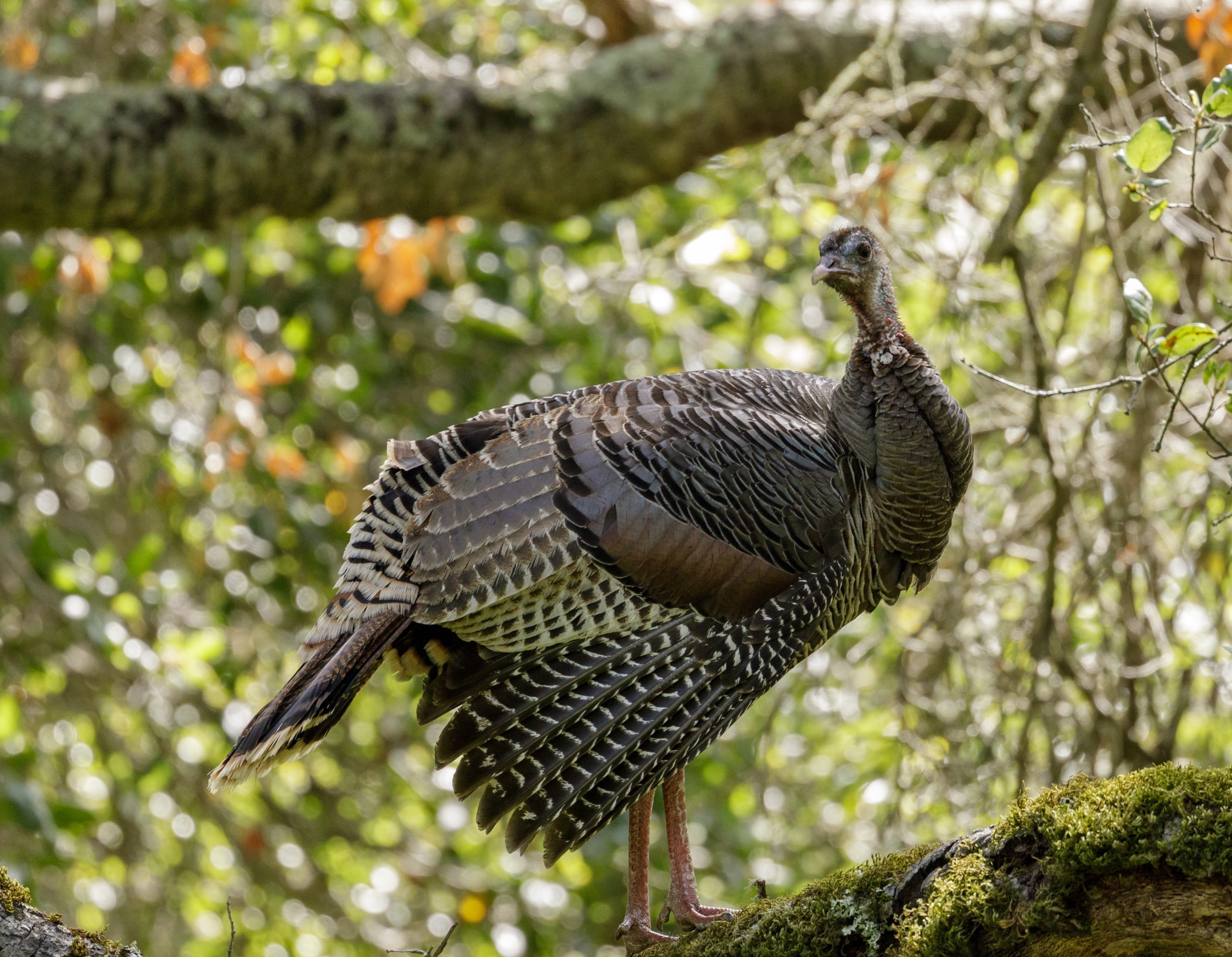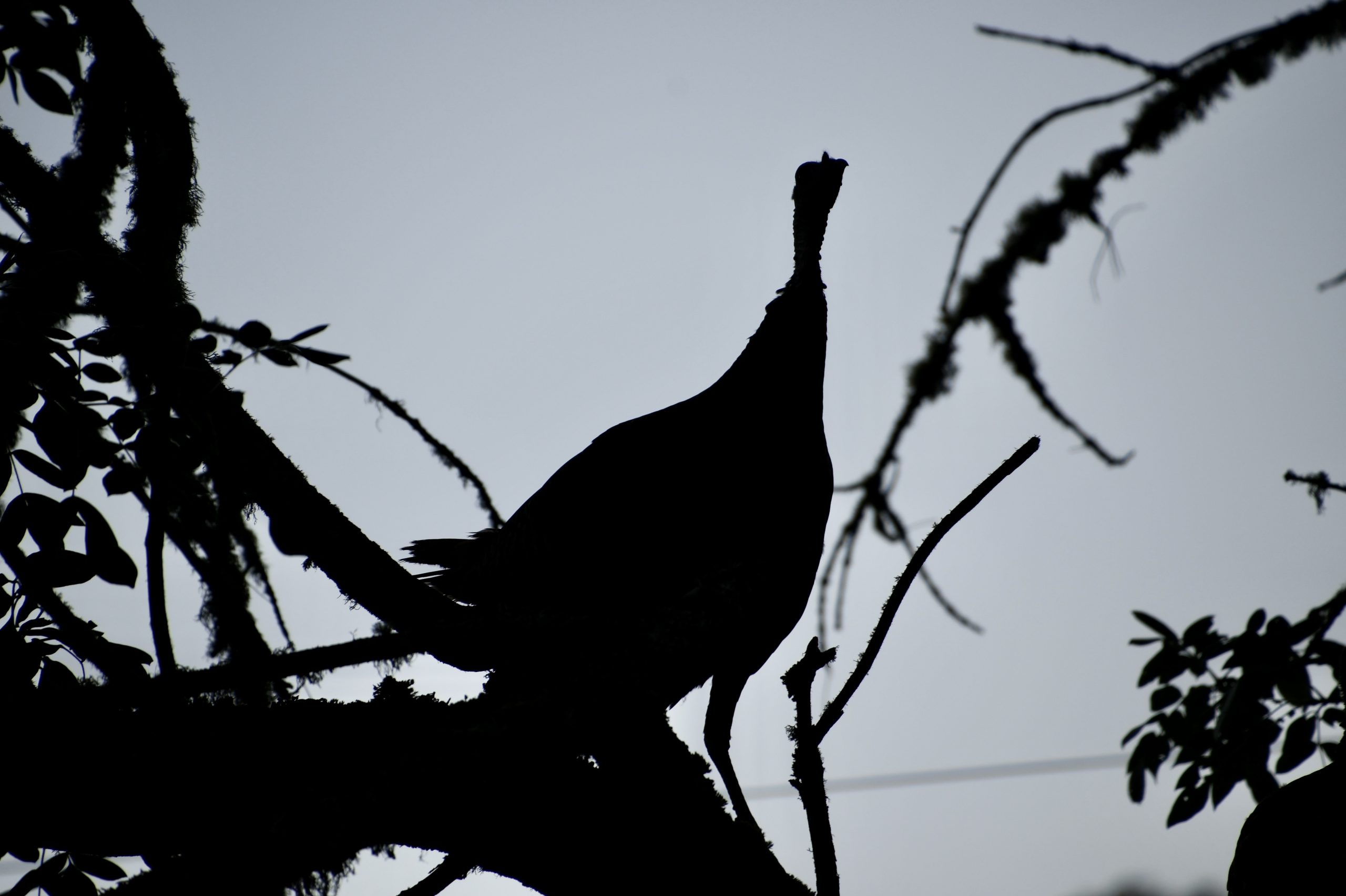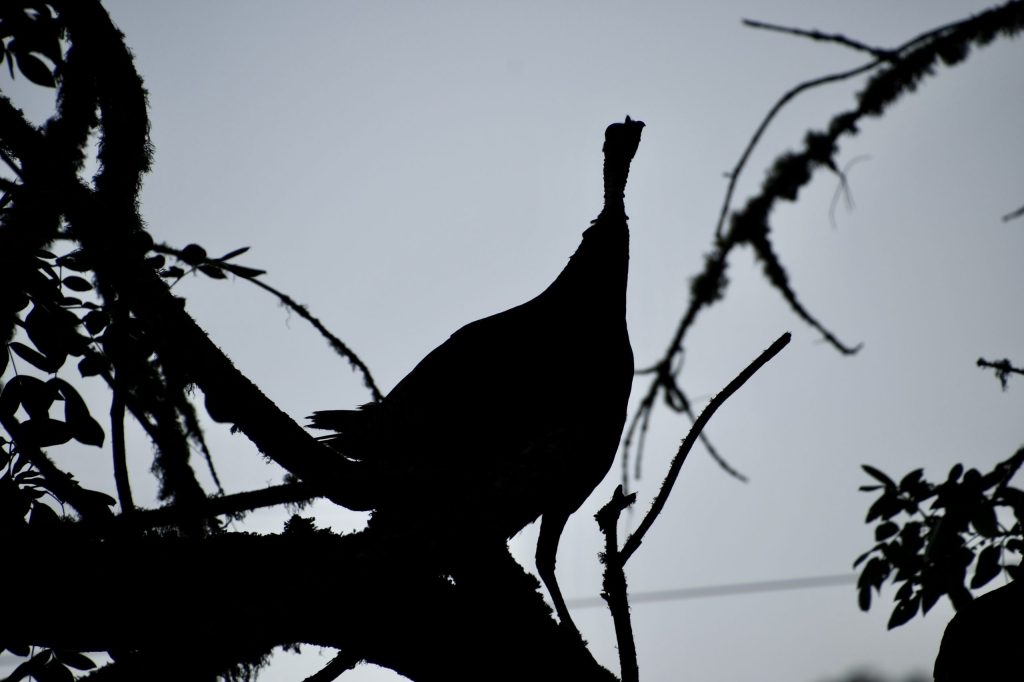I remember driving my old Volkswagen along the logging roads that crisscrossed the hills of our local hunting club in Greene County. I parked at the lowest point between two ridges, where a small creek flowed through a culvert under the road. As I searched for deer tracks, I heard a car horn in the distance. I stood and tried to separate the echo from its origin. It blasted again. A couple of ridges over, I came upon my cousin Randy standing by his truck. Before I could ask if there was a problem, he placed his index finger to his lips and whispered, “Sometimes they’ll gobble when a car door slams.” That was my introduction to what has become known as roosting a turkey to pinpoint its location as it settles in on a limb for the night.
Wild Turkey
The turkey is one of the few game animals whose first name is “Wild” and its role in history is fascinating and instructive. There are five species of wild turkeys native to North America, and they can be found from New England to Florida, westward, and southward to Central Mexico.
Native Americans hunted turkeys for their meat and feathers, used their spurs for arrow tips and wing-bones for whistles, and eventually learned to domesticate them. Like many of North America’s forest dwellers, turkey numbers dwindled with the influx of early settlers. Nevertheless, the North American turkey population rebounded from an estimated 20-30,000 around the middle of 1800 till the 1920s, when restoration efforts began. Those years reflect a steep decline in turkey numbers along with turkey hunters. The remaining birds in the Southeast fled to remote tracts of large timber, and the once numerous hunting stories shriveled with their numbers. As a result, turkey hunting largely disappeared, and a generation of outdoorsmen could only listen to the old stories passed down through a gray-haired generation.
Various state and private agencies began conservation efforts after WWll, which eventually saw wild turkey populations restored in every state except Alaska. Turkey hunting achieved a milestone in 1991 when 49 states opened spring turkey seasons in the US, along with several Canadian provinces and Mexico. According to the National Wild Turkey Federation, the wild turkey population stands at approximately 6.2 million birds with Alabama being home to about 365,000 of them.Hunters again took to the woods in growing numbers, and celebrities emerged to introduce, entertain, and teach a whole generation of new hunters about the nuanced skills needed to seduce a big gobbler within shotgun range.

So, how did our native North American turkey get its name? Several explanations have evolved regarding how the English word came about for this large bird.
One such theory is that Spanish explorers encountered indigenous populations in Mexico who had domesticated their native species. Several of these domesticated birds made their way back to Spain via ship on their return voyage. They eventually landed on the dinner tables of Europe and Middle Eastern countries via the trade route through Constantinople (Istanbul) and were called Turkey coq, a French word for fowl.
According to historians, the British habitually added the prefix turkey to many items delivered by Turkish merchants. For example, the Brits called Persian carpets Turkey rugs, Indian flour was Turkey flour, and Hungarian carpet bags were Turkey bags. However, over time the term turkey fowl transitioned to simply turkey.
Supermarket turkeys are great for Thanksgiving, but there are lessons that hunters can learn nowhere else except in the pursuit of their wild counterparts.
Locating A Roost
According to Mr. George Mayfield, roosting a turkey is a skill every hunter must master in order to increase their success rate. Many consider it a foundational step for every method of turkey hunting.
I spoke at length with Mayfield about various subjects. Still, he would not discuss the topic of roosting until he had first come full circle in describing their life cycle, terrain, strut zones, nesting areas, and pecking order. Afterward, he finished with his theory behind the evolution of modern turkey vocalization.
“Roosting a turkey” means finding where it sleeps in order to plan a successful morning hunt. Each night, as the sun sets, turkeys go to roost. Knowing its location the night before will dictate where we should hunt, no matter our method or tactics. He stated that learning the ins and outs of turkey roosting is the first step to learning turkey behavior and consistently fooling a gobbler.
Mayfield descended from a family of quail hunters, and he remembers plucking feathers into the late hours when his grandfather brought home sacks of birds.
“I began hunting turkeys about 50 years ago with friends in Mississippi,” Mayfield said. He has since hunted various species throughout the United States, been a guide, and successfully managed his own hunting lodge near Aliceville, Alabama. (The Roost)
Mayfield said he was fortunate to learn beside two of the best turkey hunters and storytellers our state has ever produced, Ben Ezell and Ben Rogers Lee. His education consisted of gleaning nuggets of truth from the many stories each told as they shared minute details after each hunt.

He said that learning what not to do was the basis for gaining enough confidence to harvest mature gobblers consistently and become proficient enough to become a successful guide and eventually enter into the business of guiding turkey and deer hunters.
Roosting/Shock Calls
According to Mayfield, a shock gobble describes an instinctive call made by turkeys as a kind of knee-jerk reaction to raucous sounds. Various loud noises, other animals, bird calls, and even thunder can elicit a gobble from an anxious Tom.
For example, slamming a car door, beeping the horn, an owl hoot, crow calls, and coyote howls can each provoke a reactive gobble to help pinpoint a roosting area near sunset. These calls must be loud enough to carry far, followed by an intense silence to hear a distant response.
Mayfield added that cruising the backroads near sunset with an open window and various calls within easy reach allows for covering a lot of terrain in short order.
Scouting For Turkeys
In flatter areas, turkeys tend to roost in the tallest trees. In the hill country, birds frequently roost along ridge lines or slightly below near a section known as the “military crest”. They tend to perch on elevated terrain if there’s any available.
According to Mayfield, twenty-year-old pines on the break of a hill make an ideal roosting site. He also said that turkeys seldom roost in the same tree each night but will be in the same general area. Groups of turkeys will sometimes use these same areas for generations until outside pressure pushes them to another location.
Mayfield estimated that only about 20% of most hunting land is suitable for turkeys, so knowing what 80% they won’t be on is a first step in narrowing your focus.
A topographical map or mapping software is a good start for whittling down areas to investigate. However, nothing can replace the need for every hunter to put in the time, effort, and sweat equity necessary to learn the habits and lessons these magnificent birds can teach those that pursue it.
Setting Up
The location of your sleeping tom is vital to set up for their fly-down at sunrise the next day. “You need a thorough knowledge of the landscape on your hunting property. Also, knowing the direction your bird will likely fly down to is critical to where you need to set up,” Mayfield said.

He also said that he never walks directly towards a roost but instead angles 8-10 degrees in his approach. Another mistake he mentioned is setting up too close. When roosting a turkey, he recommends a distance of 100-150 yards from the roost site, between where it will likely land and its strut zone.
Hunting Seasons
Several recent studies have revealed that the combined pressure from habitat degradation, predation, adverse weather, and increased hunting pressure have adversely affected the overall turkey numbers throughout the Southeast. As a result, in 2022, Alabama, Georgia, and Mississippi all saw slight changes to their traditional Spring hunting regulations, including start dates, decoy use, and bag limits.
Some studies have shown that up to 60% of gobblers are taken during the first two weeks of the Spring season before hens begin laying, which is a likely contributor to reduced poult production. So, if Alabama’s numbers don’t see an improvement in the near future, more changes may be needed.
Final Thoughts On Roosting A Turkey
Whether it’s your first or 100th time hearing the vocalization of a wild turkey, you will not soon forget it. However, mimicking the sound of another bird to coax it near enough to witness, what some have deemed- a “Redneck Peacock” is no easy feat.
This large, tail-fanning, wing-dragging bearded bird has fascinated and fed anyone willing to learn its language and habits. So, if you’re fortunate enough to share some real estate with a flock of these elusive creatures, cruise a few dirt roads with your window down this spring. Park on a hilltop, honk the horn, slam your door, and listen real close. You might get the urge to put on your hiking boots before daylight to see if you have what it takes to stalk a trophy with feathers.




